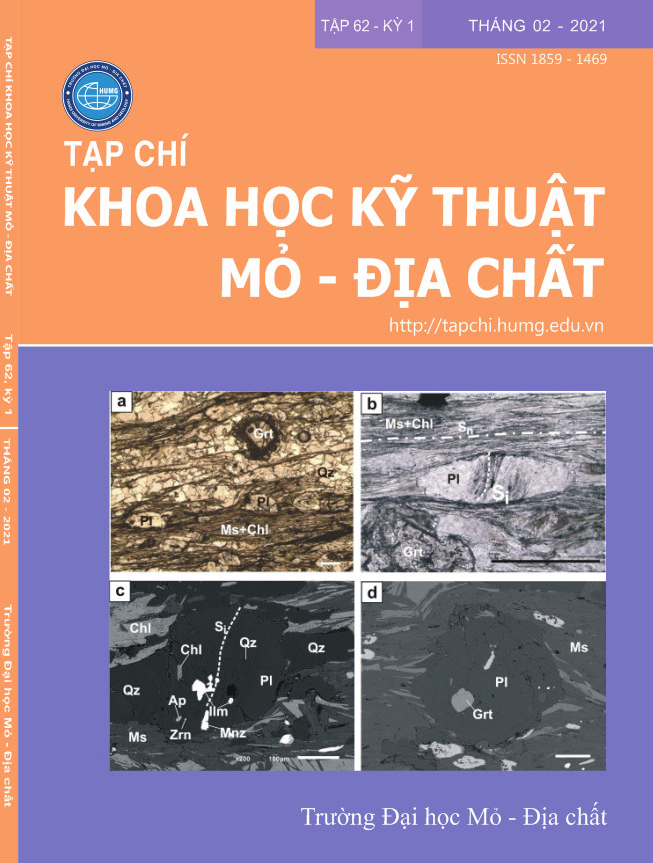Phân loại lớp phủ bề mặt khu công nghiệp Bắc Thăng Long bằng phương pháp phân loại hướng đối tượng sử dụng dữ liệu ảnh vệ tinh độ phân giải cao Worldview-2
Tóm tắt
Phân loại lớp phủ/sử dụng đất bằng ảnh vệ tinh độ phân giải cao thường gặp phải khó khăn là do sự phức tạp của bề mặt đất, nhất là đối với các khu vực đô thị. Mỗi pixel trên ảnh có thể chứa nhiều đối tượng khác nhau, hoặc bị ảnh hưởng bởi bóng của cây và các công trình xây dựng. Bài báo này sử dụng phương pháp phân loại hướng đối tượng trong việc phân loại lớp phủ nhân tạo ở khu công nghiệp sử dụng tư liệu ảnh Worldview-2 có độ phân giải không gian 1,8 m. Việc chiết tách các loại hình lớp phủ/sử dụng đất dựa vào việc phân cấp các đối tượng theo đặc trưng phổ phản xạ, chỉ số hình dạng, vị trí các đối tượng, độ sáng, chỉ số thực vật NDVI và mật độ các đối tượng mang lại hiệu quả cao về chất lượng kết quả phân loại. Kết quả phân loại lớp phủ/sử dụng đất ở khu công nghiệp Bắc Thăng Long từ dữ liệu ảnh vệ tinh độ phân giải cao Worldview-2 đạt được độ chính xác cao được thể hiện qua sai số toàn bộ (0,85) và chỉ số Kappa (0,81).Tài liệu tham khảo
Aatz, M., Benz, U., Dehghani, S., Heynen, M., Höltje, A., Hofmann, P., Lingenfelder, I., Mimler, M., Sohlbach, M., Weber, M., & Willhauck, G., (2004), eCognition Professional: User guide 4.; Munich: Definiens-Imaging.
Belward, A.S., Skøien, J.O., (2015). Who launched what, when and why; trends in global land-cover observation capacity from civilian earth observation satellites, ISPRS J. Photogram. Remote Sens., 103, pp. 115-128,
Choodarathnakara, A.L., Ashok, K.T., Shivaprakash, K Dr., and Patil Dr.C.G., (2012). Soft Classification Techniques for RS Data, IJCSET, 2 (11), pp.1468 - 1471.
Congalton, R. G. and Green, K., (2008). Assessing the accuracy of remotely sensed data: Principies and practices. New York. Taylor& Francis Group.
Desheng Liu and Fanxia, (2010). Assessing object-based classification: advantages and limitations. Remote Sensing Letters, ISSN: 2150-704X (Print) 2150-7058 (Online).
Digitalglobal, (2009). WorldView-2 Satellite Sensor.
Guo, Q., Kelly, M., Gong, P. and Liu, D., (2007). An object-based classification approach in mapping tree mortality using high spatial resolution imagery. GIScience & Remote Sensing, 44, pp. 24-47.
Kamal, M.; Phinn, S.; Johansen, K., (2015). Object-Based Approach for Multi-Scale Mangrove Composition Mapping Using Multi-Resolution Image Datasets. Remote Sens 7, 4753-4783.
Kavzoglu, T.; Yildiz, M., (2014). Parameter-Based Performance Analysis of Object-Based Image Analysis Using Aerial and Quikbird-2 Images. ISPRS Annals of Photogrammetry, Remote Sensing and Spatial Information Sciences, Volume II-7, pp.31-37.
Manakos, I., (2001). eCognition and Precision Farming. http://www.lrz-muenchen.de/~lnn /. eCognition Application Notes, Vol. 2, No 2, April 2001.
Mario, C., (2009). ESA Advanced Training Course on Land Remote Sensing: Image Classification, ESA
Mitri, G.H., and Gitas, I.Z.,(2002). The development of an object-oriented classification model for operational burned area mapping on the Mediterranean island of Thasos using LANDSAT TM images. Forest Fire Research & Wildland Fire Safety, Viegas (ed.) Millpress, Rotterdam, ISBN 90-77017-72-0.
Qihao Weng, (2020). Techniques and Methods in Urban Remote Sensing, IEEE Press Wiley, Printed in the United States of America.
Whiteside, T., & Ahmad, W., (2004). Object-oriented classification of ASTER imagery for landcover mapping in monsoonal northern Australia. Proceedings of 12th Australasian Remote Sensing and Photogrammetry Conference.
Willhauck, G., Schneider, T., De Kok, R., & Ammer, U., (2000). Comparison of object-oriented classification techniques and standard image analysis for the use of change detection betweeen SPOT multispectral satellite images and aerial photos. Proceedings of XIX ISPRS Congress, 16-22 July, Amsterdam.


